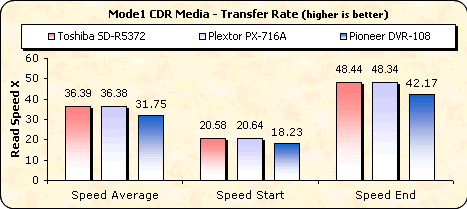Toshiba SD-R5372
2. Transfer Rate Reading Tests
Review Pages
2. Transfer Rate Reading Tests
3. CD Error Correction Tests
4. DVD Error Correction Tests
5. Protected Disc Tests
6. DAE Tests
7. Protected AudioCDs
8. CD Recording Tests
9. Writing Quality Tests - 3T Jitter Tests
10. Writing Quality Tests - Clover System Tests
11. DVD Recording Tests
12. CDSpeed/PlexTools Scans - Page 1
13. CDSpeed/PlexTools Scans - Page 2
14. CDSpeed/PlexTools Scans - Page 3
15. CDSpeed/PlexTools Scans - Page 4
16. CDSpeed/PlexTools Scans - Page 5
17. CDSpeed/PlexTools Scans - Page 6
18. CDSpeed/PlexTools Scans - Page 7
19. CDSpeed/PlexTools Scans - Page 8
20. CDSpeed/PlexTools Scans - Page 9
21. DVD+R DL - Page 1
22. DVD+R DL - Page 2
23. BookType Setting
24. Supported Media list
25. Conclusion
In order to confirm the drive's specifications for CD reading, we used one CD pressed media, a copy on a CD-R and one HS-RW media. The results are illustrated in the following graphs.
- CD Format



The drive managed to confirm the manufacturer's specifications for this task. Although it was fast reading CDs, with HS-RW media it was much slower than the competition.
- DVD Format
We repeated the same tests with DVD media this time.

The reported speeds from all three drives were very close with the Toshiba being slightly faster but with negligible difference.
The following DVD is a PTP DVD-ROM where the two layers of the disc are read sequentially with the drive starting reading from the inner part of the disc, which is the beginning of each layer, progressing towards the outer range for each layer. The Pioneer drive was the fastest due to its higher supported speed. Unfortunately, the Toshiba was the slowest by a great margin.

The graph shown below shows the reading performance of the TS-H552 with OTP dual layer media. The first layer of an OTP dual layer DVD-ROM is read exactly the same way as the first layer of the PTP disc we tested previously. The difference here is the reading strategy of the second layer on the disc. The beginning of the second layer is located in the outer part of the disc, so the drive starts reading from the outer tracks towards the inner part of the disc. The performance is almost the same as the previous case with the PTP disc.

In the following graphs we compare the reading performance with recordable and rewritable media. Toshiba proved to be the faster reader with DVD±R media. On the other hand, it didn't manage to maintain this supremacy with DVD±RW media. The Plextor drive, despite not being the fastest with the DVD±R formats, was was fastest with RW and the most stable overall, reporting similar speeds for all four formats.


We ripped the contents of a pressed Double Layer movie to the hard disk using the Toshiba drive and DVD Decrypter. The results are summarized below:

The reported transfer rate for the Toshiba is good but Plextor is unbeatable in this task.
One of the few drives that supports DVD-RAM reading and was the only one to do so in our comparison.
-Appendix Nero CD-DVD Speed Graphs
- CD Pressed / CD-R / US-RW
- DVD Pressed SL / DVD Pressed PTP DL / DVD Pressed OTP DL / DVD-R / DVD-RW / DVD+R / DVD+RW
Review Pages
2. Transfer Rate Reading Tests
3. CD Error Correction Tests
4. DVD Error Correction Tests
5. Protected Disc Tests
6. DAE Tests
7. Protected AudioCDs
8. CD Recording Tests
9. Writing Quality Tests - 3T Jitter Tests
10. Writing Quality Tests - Clover System Tests
11. DVD Recording Tests
12. CDSpeed/PlexTools Scans - Page 1
13. CDSpeed/PlexTools Scans - Page 2
14. CDSpeed/PlexTools Scans - Page 3
15. CDSpeed/PlexTools Scans - Page 4
16. CDSpeed/PlexTools Scans - Page 5
17. CDSpeed/PlexTools Scans - Page 6
18. CDSpeed/PlexTools Scans - Page 7
19. CDSpeed/PlexTools Scans - Page 8
20. CDSpeed/PlexTools Scans - Page 9
21. DVD+R DL - Page 1
22. DVD+R DL - Page 2
23. BookType Setting
24. Supported Media list
25. Conclusion






















